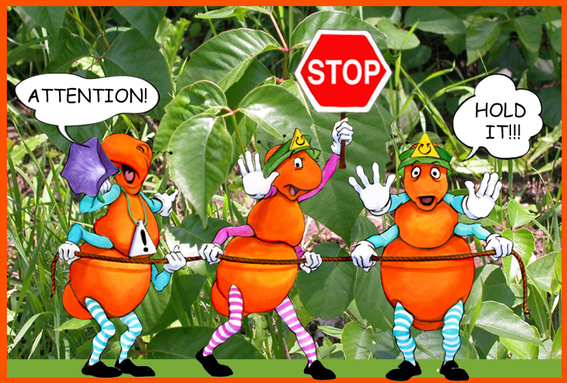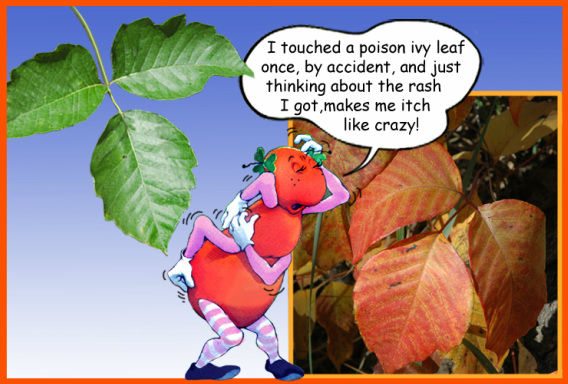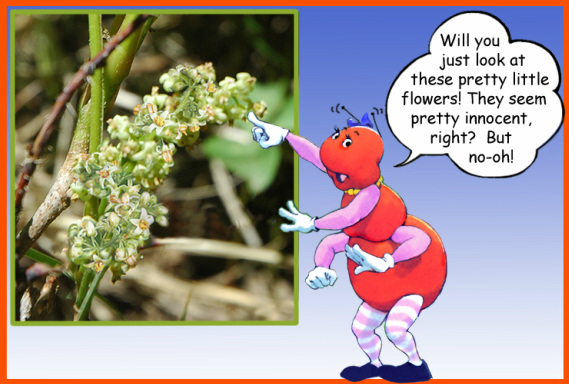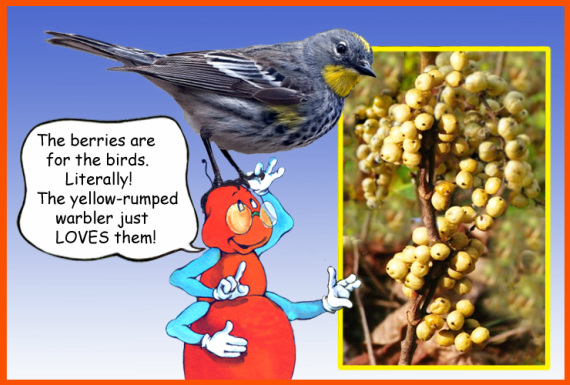PLANT OF THE MONTH: POISON IVY

NEWS ALERT!
The PatrolAnts have found another patch of Poison Ivy!
It's just what it sounds like: Poison - at least for human beings.
It climbs. It creeps. It can even become a big bush.
If ANY part of this plant touches your skin- you can get a really nasty rash!
If that should happen, splash your skin right away with water or hop in a stream if there is one nearby!
Not everyone gets a rash, but most humans do.
This doesn't mean you should be afraid to go out in nature. Just learn the DO's and DON'T's where YOU live.
So, we gallavants want to show you some pictures and give you some info about Poison Ivy, our Plant Of the Month, so you can learn to recognize it and avoid it altogether.
The PatrolAnts have found another patch of Poison Ivy!
It's just what it sounds like: Poison - at least for human beings.
It climbs. It creeps. It can even become a big bush.
If ANY part of this plant touches your skin- you can get a really nasty rash!
If that should happen, splash your skin right away with water or hop in a stream if there is one nearby!
Not everyone gets a rash, but most humans do.
This doesn't mean you should be afraid to go out in nature. Just learn the DO's and DON'T's where YOU live.
So, we gallavants want to show you some pictures and give you some info about Poison Ivy, our Plant Of the Month, so you can learn to recognize it and avoid it altogether.

Let's start with the leaves.
Poison Ivy has "compound leaves" on a green stem starting out from a grayish brown stalk.
Three pointed leaflets grow from the same point. The stem of the middle leaf is a little bit longer.
A good rule to remember: "LEAVES OF THREE - LET IT BE!"
The edges of the leaves can be smooth or jagged. The new, young leaves are reddish and shiny when they appear in the spring. They later become green, staying that way through the summer months. These leaves can be shiny or dull, some are even a bit fuzzy.
Like many other plants they turn yellow, orange or red in the fall. They look really beautiful but, Great Mama Gaia! can they get you into trouble - an itchy, blistering rash of trouble! Of course there are many plants with three leaves growing together but we'll show you some other things to look for.
Poison Ivy has "compound leaves" on a green stem starting out from a grayish brown stalk.
Three pointed leaflets grow from the same point. The stem of the middle leaf is a little bit longer.
A good rule to remember: "LEAVES OF THREE - LET IT BE!"
The edges of the leaves can be smooth or jagged. The new, young leaves are reddish and shiny when they appear in the spring. They later become green, staying that way through the summer months. These leaves can be shiny or dull, some are even a bit fuzzy.
Like many other plants they turn yellow, orange or red in the fall. They look really beautiful but, Great Mama Gaia! can they get you into trouble - an itchy, blistering rash of trouble! Of course there are many plants with three leaves growing together but we'll show you some other things to look for.

The flowers of the Poison Ivy plant are tiny and green, yellow and white. They grow together in clusters.
These bunches of beauty shoot up from the main stalk, where the leaf stems start out.
Poison Ivy blooms from May to July, but don't even think of getting close enough to smell these little flowers!
The whole plant contains an oil, called
"urushiol", which is what causes the trouble for humans in the first place.
The oil is not actually poison in itself, but it's an allergic reaction to it, that gets people into trouble.
If the plant is bruised or touched this oil
can get on people's skin. And this is one very sensitive plant! For some strange reason all kinds of animals can touch, sniff and munch on the whole plant without being bothered. Deer, raccoons and other animals love it, but humans - STAY CLEAR, please!
These bunches of beauty shoot up from the main stalk, where the leaf stems start out.
Poison Ivy blooms from May to July, but don't even think of getting close enough to smell these little flowers!
The whole plant contains an oil, called
"urushiol", which is what causes the trouble for humans in the first place.
The oil is not actually poison in itself, but it's an allergic reaction to it, that gets people into trouble.
If the plant is bruised or touched this oil
can get on people's skin. And this is one very sensitive plant! For some strange reason all kinds of animals can touch, sniff and munch on the whole plant without being bothered. Deer, raccoons and other animals love it, but humans - STAY CLEAR, please!

Now to the fruits!
In the late summer the pollinated flowers produce yellowish, white, waxy-looking berries.
Migrating birds like to eat them on their way flying south.
The berries are nutritious and give birds and other animals some yummy meals.
Then the seeds of the berries pass right through and get dropped in new and different places with the poop from whatever bird or animal that had them for dinner.
So this is ONE way the Poison Ivy plant can spread and continue to multiply.
Don't touch these either!
They truly are just for the birds.
In the late summer the pollinated flowers produce yellowish, white, waxy-looking berries.
Migrating birds like to eat them on their way flying south.
The berries are nutritious and give birds and other animals some yummy meals.
Then the seeds of the berries pass right through and get dropped in new and different places with the poop from whatever bird or animal that had them for dinner.
So this is ONE way the Poison Ivy plant can spread and continue to multiply.
Don't touch these either!
They truly are just for the birds.

The root system of the common Poison Ivy plant grows right under the surface of the soil.
The main root grows sideways and has smaller roots growing downward soaking up nutrition from the soil.
Here and there along this main root, new shoots poke up through the soil producing whole, new, separate plants. And that's how Poison Ivy can spread underground.
Some of the climbing Poison Ivy plants grow roots that look like fuzzy ropes on the trunks of the tree, or fence or whatever the vine is climbing on.
These roots can be thick or stringy.
They are called: "aerial roots".
We gallavants don't go anywhere near ANY part of this plant and neither should you! Also check your area for cousins to this plant, such as: Poison Oak and Poison Sumac.
The main root grows sideways and has smaller roots growing downward soaking up nutrition from the soil.
Here and there along this main root, new shoots poke up through the soil producing whole, new, separate plants. And that's how Poison Ivy can spread underground.
Some of the climbing Poison Ivy plants grow roots that look like fuzzy ropes on the trunks of the tree, or fence or whatever the vine is climbing on.
These roots can be thick or stringy.
They are called: "aerial roots".
We gallavants don't go anywhere near ANY part of this plant and neither should you! Also check your area for cousins to this plant, such as: Poison Oak and Poison Sumac.

Well, that's some info about the Plant Of the Month: Poison Ivy.
We hope you can learn to recognize it and stay clear of it.
Perhaps wear long pants and sneakers when you're in the woods or walking along hiking paths?
Poison Ivy needs a lot of sun, so you may not find it in deep, dark forests.
One wonderful gift this plant gives us all, is that we become more AWARE of the stuff growing and living out in nature.
We look. We see. We do pay more attention to everything around us.
And that can help us and you humans use and develop your sixth sense. The sixth sense is also called intuition, which is very useful in keeping you safe and secure wherever you are! So, keep exploring all the wonders that nature has to offer and just watch where you're going and, of course, make sure you have SPARC!
We hope you can learn to recognize it and stay clear of it.
Perhaps wear long pants and sneakers when you're in the woods or walking along hiking paths?
Poison Ivy needs a lot of sun, so you may not find it in deep, dark forests.
One wonderful gift this plant gives us all, is that we become more AWARE of the stuff growing and living out in nature.
We look. We see. We do pay more attention to everything around us.
And that can help us and you humans use and develop your sixth sense. The sixth sense is also called intuition, which is very useful in keeping you safe and secure wherever you are! So, keep exploring all the wonders that nature has to offer and just watch where you're going and, of course, make sure you have SPARC!